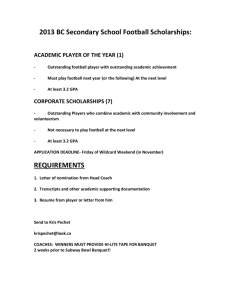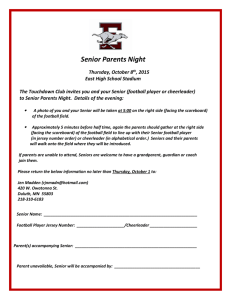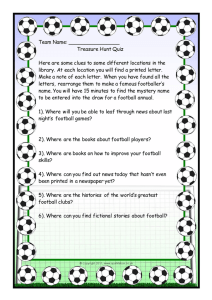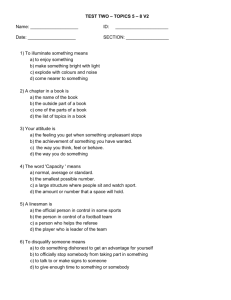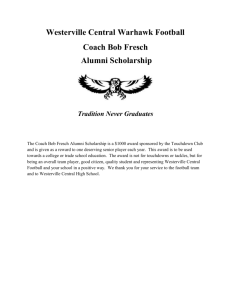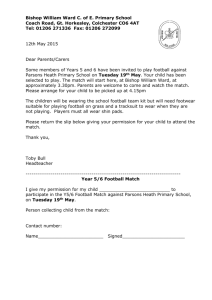Football Pacing Guide
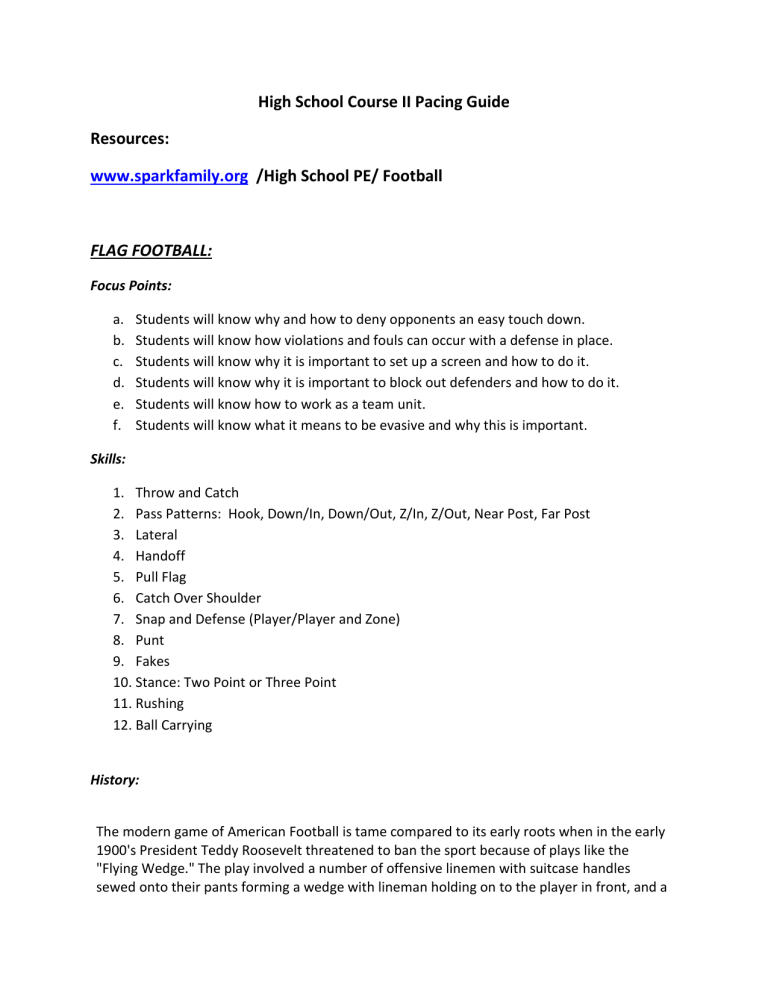
High School Course II Pacing Guide
Resources: www.sparkfamily.org
/High School PE/ Football
FLAG FOOTBALL:
Focus Points: a.
Students will know why and how to deny opponents an easy touch down. b.
Students will know how violations and fouls can occur with a defense in place. c.
Students will know why it is important to set up a screen and how to do it. d.
Students will know why it is important to block out defenders and how to do it. e.
Students will know how to work as a team unit. f.
Students will know what it means to be evasive and why this is important.
Skills:
1.
Throw and Catch
2.
Pass Patterns: Hook, Down/In, Down/Out, Z/In, Z/Out, Near Post, Far Post
3.
Lateral
4.
Handoff
5.
Pull Flag
6.
Catch Over Shoulder
7.
Snap and Defense (Player/Player and Zone)
8.
Punt
9.
Fakes
10.
Stance: Two Point or Three Point
11.
Rushing
12.
Ball Carrying
History:
The modern game of American Football is tame compared to its early roots when in the early
1900's President Teddy Roosevelt threatened to ban the sport because of plays like the
"Flying Wedge." The play involved a number of offensive linemen with suitcase handles sewed onto their pants forming a wedge with lineman holding on to the player in front, and a
ball carrier safely positioned in the middle. As the "wedge" rumbled down the field the opposition players went "flying" and were left in a crumpled mass on the ground in its wake.
With so many broken bones and other serious injuries- even deaths, safety rules had to be applied. Thus helmets, shoulder pads and other protective equipment now define the modern game of football.
But not Flag Football ... no helmets and shoulder pads allowed ...
The game of American football has been played since the mid-1800's. The first College game occurred between Princeton and Rutgers on Nov. 6, 1869. And the professional game has been played in some form since 1895.
The game of Touch and Flag Football has been around nearly as long as tackle football.
The first remembrance of organized Touch and Tail Football being played was in the 1930's.
Flag football was developed on military bases in the early 1940's as a recreational sport for military personal. Recreational leagues soon developed in the late 40's early 50's. They were patterned around the softball league format and the game we know and love today was born.
Strategies:
1.
Passing accuracy against a defense using a set play.
2.
Man-on-man defense- player takes responsibility for covering one opponent
3.
Zone defense- player takes responsibility for covering an area
4.
Blocking defensive players for advancement of ball.
5.
Optimal placement of players based on skill set.
Assessment: a.
Performance rubric b.
Peer Checklist c.
Written quiz
Vocabulary:
Review the components of skill-related fitness: a.
Agility – ability to change your body position quickly and to control your body’s movements. b.
Balance – An even distribution of weight enabling someone or something to remain upright and steady. c.
Coordination – ability to use your senses together with your body parts.
d.
Explosive power – A quick muscular effort resulting in speed and/or power for a short period of time. Examples include tee shot, batting, tennis serve, basketball rebound, football tackle, etc. e.
Power – ability to use strength quickly. Areas most likely to improve with repeated effort. f.
Reaction time – amount of time it takes you to move once you realize the need to act. g.
Speed – ability to perform a movement or cover a distance in a short period of time.
Review the principles of biomechanics: a.
Force – A push or a pull applied to an object or person, measured in pounds or newtons. b.
Inertia – The tendency of a body at rest to remain at rest or of a body in straight line motion to stay in motion in a straight line unless acted on by an outside force.
Leverage – 1. a. The action of a lever. b. The mechanical advantage of a lever. 2. Positional c.
d.
advantage; power to act effectively
Opposition - The use of body parts on opposite sides of body to increase force and power. e.
Rotary Motion – The act of rotating as if on an axis; "the rotation of the dancer kept time with the music."

